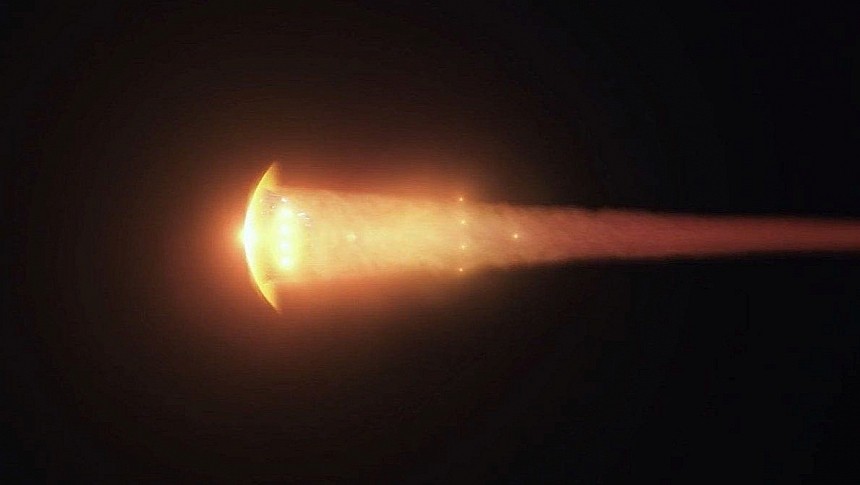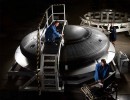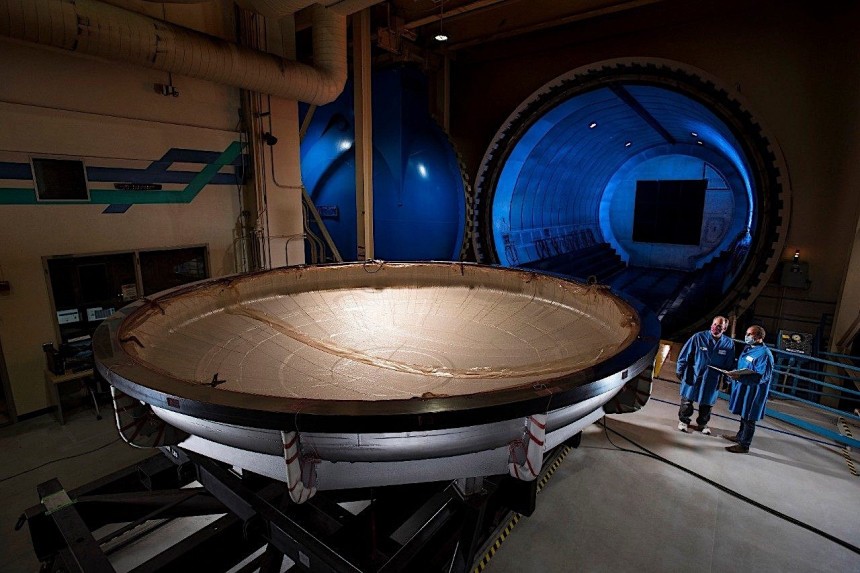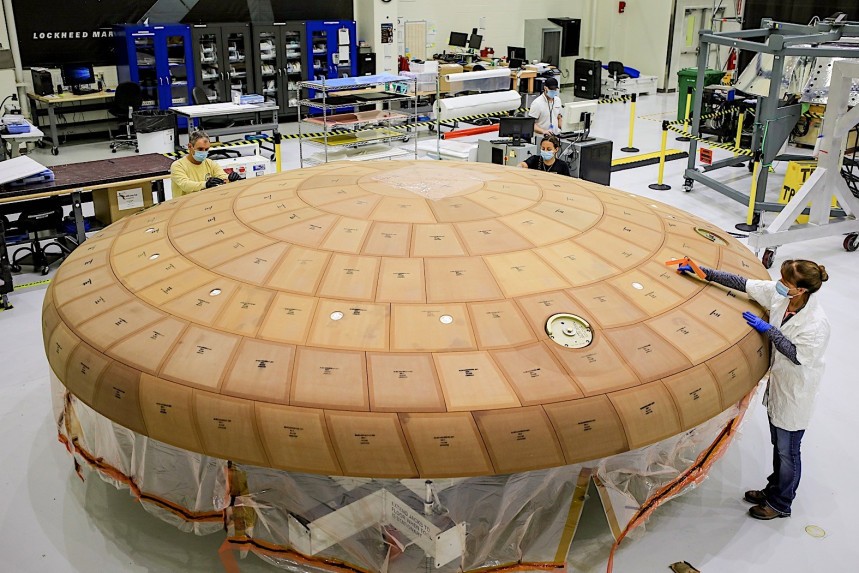At the end of June we got word of the Orion spaceship meant for the crewed Artemis II mission having its heat shield installed. It's a piece of news that brings the reality of human flight to the Moon and back a step closer, but also opens up our appetite for having a closer look at what the heat shield is all about.
Ever since humans took to space for the first time all those many decades ago, they knew the hardest parts of any mission are the actual launch and the re-entry.
The launch is dangerous for obvious reasons. Astronauts sit inside small capsules on top of cylinders filled with, basically, explosive substances, and wait for the fuel to meet the spark that ignites it.
Years upon years of crewed missions have proven though that, overall, rocket launches with humans on board are safe. And, generally speaking, so are re-entries, thanks to a wonderful invention called the heat shield.
When coming back from space and trying to reach Earth's surface, spaceships slam into the atmosphere at extremely high speeds. The impact is not dangerous in itself, but what happens next is.
Having made the transition from void to atmosphere, spacecraft encounter a lot of friction. This helps slow the ship down significantly in a very short period of time, and as you know from school physics, friction generates heat. A lot of it, in our case, to obliterate a spacecraft going through the atmosphere unprotected.
That protection is called a heat shield, and has been used since forever. Made from various materials, it goes on the underside of a spaceship, the side facing the planet, and helps eliminate the heat generated during descent by pointing it away and eating it up.
All spacecraft have heat shields, but the one which was already used during the Artemis I mission of last year and will continue to be used throughout the program is the most advanced yet.
At its core is a material used Avcoat. Dating back to the days of the Apollo program, it is in essence a an epoxy resin fixed in a fiberglass honeycomb matrix using additives.
Avcoat is an ablator, meaning it's meant to gradually and controllably burn off, taking excess heat away with it in the process.
For its use on the Orion the production process for the material has been upgraded, allowing for a layer of Avcoat measuring between one and three inches thick (2.5 to 7.6 cm) to be pulled over the heat shield's carbon fiber skin.
From place to place, especially at the connection points between the shield and the spacecraft, another material is used. It's called 3-Dimensional Multifunctional Ablative Thermal Protection System (3DMAT) and is made of woven threads of quartz in resin, making it stronger even than the Avcoat.
The details above may not paint a clear picture of what the shield is capable of, but the numbers below will.
Compared to a spaceship descending from low-Earth orbit, a lunar spacecraft reaches the space around the planet's atmosphere a lot faster in terms of speed on the trip back. In the case of the Artemis, the speed at which it enters the atmosphere is 25,000 mph (40,233 kph). Instantly the speed starts to drop, reaching just 300 mph (483 kph) in mere minutes.
This process generates temperatures outside the ship twice as high as molten lava, and half that on the surface of the Sun: 5,000 degrees Fahrenheit (2,760 Celsius).
The heat shield is capable of managing all that heat, and the occupants inside the ship should only feel a comfortable 70 degrees Fahrenheit (21 degrees Celsius).
According to Lockheed Martin, the crew behind the Orion heat shield, the shield sheds enough mechanical energy in the process of dissipating heat to power 5,000 average American homes for a full day.
The shield proved its worth after it successfully protected Orion during the Artemis I mission. Its next job will however be a lot more important, as it'll need to safeguard not only gear, but also the lives of four astronauts.
Artemis II is at the moment on track to depart for the Moon at the end of 2024. Although it will not place astronaut boots on the Moon after a hiatus decades-long, the mission will enter the history books for a series of firsts.
At a crew level, Artemis II is the first ever Moon mission to include a person of color (pilot Victor Glover), a woman (mission specialist Christina Hammock Koch), and a Canadian (mission specialist Jeremy Hansen).
At a mission level, Orion will take the crew to the farthest point from Earth ever reached by a human being, 230,000 miles (370,000 km). That's beyond the orbit of the Moon by a staggering 6,400 miles (10,300 km).
Thanks to the heat shield installed on the ship, the crew will be able to tell their stories as soon as they land, and who knows of what wonders, seen through human eyes, we'll all learn about?
The launch is dangerous for obvious reasons. Astronauts sit inside small capsules on top of cylinders filled with, basically, explosive substances, and wait for the fuel to meet the spark that ignites it.
Years upon years of crewed missions have proven though that, overall, rocket launches with humans on board are safe. And, generally speaking, so are re-entries, thanks to a wonderful invention called the heat shield.
When coming back from space and trying to reach Earth's surface, spaceships slam into the atmosphere at extremely high speeds. The impact is not dangerous in itself, but what happens next is.
Having made the transition from void to atmosphere, spacecraft encounter a lot of friction. This helps slow the ship down significantly in a very short period of time, and as you know from school physics, friction generates heat. A lot of it, in our case, to obliterate a spacecraft going through the atmosphere unprotected.
That protection is called a heat shield, and has been used since forever. Made from various materials, it goes on the underside of a spaceship, the side facing the planet, and helps eliminate the heat generated during descent by pointing it away and eating it up.
At its core is a material used Avcoat. Dating back to the days of the Apollo program, it is in essence a an epoxy resin fixed in a fiberglass honeycomb matrix using additives.
Avcoat is an ablator, meaning it's meant to gradually and controllably burn off, taking excess heat away with it in the process.
For its use on the Orion the production process for the material has been upgraded, allowing for a layer of Avcoat measuring between one and three inches thick (2.5 to 7.6 cm) to be pulled over the heat shield's carbon fiber skin.
From place to place, especially at the connection points between the shield and the spacecraft, another material is used. It's called 3-Dimensional Multifunctional Ablative Thermal Protection System (3DMAT) and is made of woven threads of quartz in resin, making it stronger even than the Avcoat.
The details above may not paint a clear picture of what the shield is capable of, but the numbers below will.
Compared to a spaceship descending from low-Earth orbit, a lunar spacecraft reaches the space around the planet's atmosphere a lot faster in terms of speed on the trip back. In the case of the Artemis, the speed at which it enters the atmosphere is 25,000 mph (40,233 kph). Instantly the speed starts to drop, reaching just 300 mph (483 kph) in mere minutes.
The heat shield is capable of managing all that heat, and the occupants inside the ship should only feel a comfortable 70 degrees Fahrenheit (21 degrees Celsius).
According to Lockheed Martin, the crew behind the Orion heat shield, the shield sheds enough mechanical energy in the process of dissipating heat to power 5,000 average American homes for a full day.
The shield proved its worth after it successfully protected Orion during the Artemis I mission. Its next job will however be a lot more important, as it'll need to safeguard not only gear, but also the lives of four astronauts.
Artemis II is at the moment on track to depart for the Moon at the end of 2024. Although it will not place astronaut boots on the Moon after a hiatus decades-long, the mission will enter the history books for a series of firsts.
At a crew level, Artemis II is the first ever Moon mission to include a person of color (pilot Victor Glover), a woman (mission specialist Christina Hammock Koch), and a Canadian (mission specialist Jeremy Hansen).
At a mission level, Orion will take the crew to the farthest point from Earth ever reached by a human being, 230,000 miles (370,000 km). That's beyond the orbit of the Moon by a staggering 6,400 miles (10,300 km).
Thanks to the heat shield installed on the ship, the crew will be able to tell their stories as soon as they land, and who knows of what wonders, seen through human eyes, we'll all learn about?

















